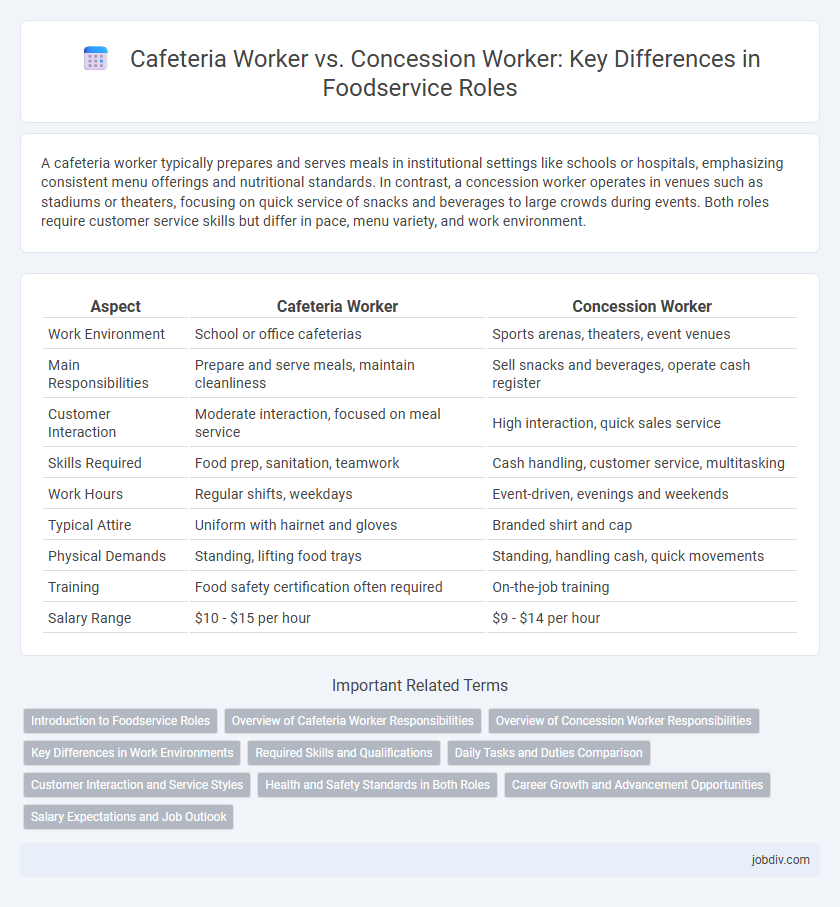A cafeteria worker typically prepares and serves meals in institutional settings like schools or hospitals, emphasizing consistent menu offerings and nutritional standards. In contrast, a concession worker operates in venues such as stadiums or theaters, focusing on quick service of snacks and beverages to large crowds during events. Both roles require customer service skills but differ in pace, menu variety, and work environment.
Table of Comparison
| Aspect | Cafeteria Worker | Concession Worker |
|---|---|---|
| Work Environment | School or office cafeterias | Sports arenas, theaters, event venues |
| Main Responsibilities | Prepare and serve meals, maintain cleanliness | Sell snacks and beverages, operate cash register |
| Customer Interaction | Moderate interaction, focused on meal service | High interaction, quick sales service |
| Skills Required | Food prep, sanitation, teamwork | Cash handling, customer service, multitasking |
| Work Hours | Regular shifts, weekdays | Event-driven, evenings and weekends |
| Typical Attire | Uniform with hairnet and gloves | Branded shirt and cap |
| Physical Demands | Standing, lifting food trays | Standing, handling cash, quick movements |
| Training | Food safety certification often required | On-the-job training |
| Salary Range | $10 - $15 per hour | $9 - $14 per hour |
Introduction to Foodservice Roles
Cafeteria workers primarily manage food preparation, serving, and maintaining hygiene standards in institutional settings such as schools and hospitals, ensuring efficient meal distribution to large groups. Concession workers specialize in selling snacks and beverages at entertainment venues, focusing on customer service and quick transaction handling. Both roles require knowledge of food safety regulations and effective communication skills to deliver quality foodservice experiences.
Overview of Cafeteria Worker Responsibilities
Cafeteria workers manage food preparation, serving, and maintaining cleanliness in institutional dining settings like schools and corporate cafeterias. Their responsibilities include portion control, operating food service equipment, and ensuring compliance with health and safety regulations. They also assist in inventory management and customer service, contributing to efficient foodservice operations.
Overview of Concession Worker Responsibilities
Concession workers are responsible for preparing and serving food and beverages at events, ensuring quick and efficient customer service while maintaining food safety standards. They operate point-of-sale systems, manage inventory of snacks and supplies, and keep the concession area clean and well-organized. Concession workers also handle cash transactions and provide a friendly customer experience in high-traffic environments such as stadiums, theaters, and fairs.
Key Differences in Work Environments
Cafeteria workers typically operate in structured institutional settings such as schools, hospitals, and corporate cafeterias, where meal preparation and service follow set schedules and nutritional guidelines. Concession workers usually work in dynamic environments like sports arenas, theaters, and event venues, requiring fast-paced service and handling diverse food items like snacks and beverages. These differences influence job responsibilities, pace, and customer interaction in each role.
Required Skills and Qualifications
Cafeteria workers require strong food preparation skills, knowledge of health and safety regulations, and the ability to operate kitchen equipment efficiently. Concession workers need excellent customer service abilities, cash handling experience, and the capacity to work quickly in high-traffic environments. Both roles demand teamwork, attention to detail, and adherence to hygiene standards.
Daily Tasks and Duties Comparison
Cafeteria workers primarily focus on food preparation, serving meals, and maintaining cleanliness in institutional settings such as schools or hospitals. Concession workers handle ticket sales, operate food and beverage stands, and manage inventory at events or entertainment venues. Both roles require customer service skills, but cafeteria workers emphasize meal assembly and sanitation, while concession workers prioritize quick sales and product restocking.
Customer Interaction and Service Styles
Cafeteria workers typically serve meals in a self-service or buffet-style setting, allowing customers to select their food with minimal direct interaction. Concession workers engage in fast-paced environments, often at events, providing quick, personalized service while handling payments and order customizations. Both roles emphasize efficient customer interaction but differ in service style and the level of face-to-face engagement.
Health and Safety Standards in Both Roles
Cafeteria workers and concession workers both adhere to strict health and safety standards, including proper food handling, sanitation, and personal hygiene to prevent contamination. Cafeteria workers often manage larger-scale food preparation with routine inspections ensuring compliance with local health codes, while concession workers focus on maintaining clean, safe serving areas in fast-paced environments such as stadiums or event venues. Both roles require ongoing training in allergen awareness and emergency response protocols to protect customer health and safety.
Career Growth and Advancement Opportunities
Cafeteria workers typically experience steady career growth through roles such as shift leader or kitchen supervisor within institutional settings like schools or hospitals. Concession workers often advance by moving into management positions at larger venues or event facilities, leveraging high-volume service experience. Both roles offer opportunities to develop food safety certifications and operational skills that enhance promotion potential in the foodservice industry.
Salary Expectations and Job Outlook
Cafeteria workers typically earn an average hourly wage ranging from $10 to $14, with steady demand driven by schools, hospitals, and corporate dining facilities leading to consistent job stability. Concession workers usually receive slightly lower pay, around $9 to $12 per hour, but experience fluctuating job opportunities tied to seasonal events and entertainment venues. Both roles require basic food handling skills, yet cafeteria positions tend to offer more reliable hours and benefits compared to concession jobs.
Cafeteria Worker vs Concession Worker Infographic

 jobdiv.com
jobdiv.com